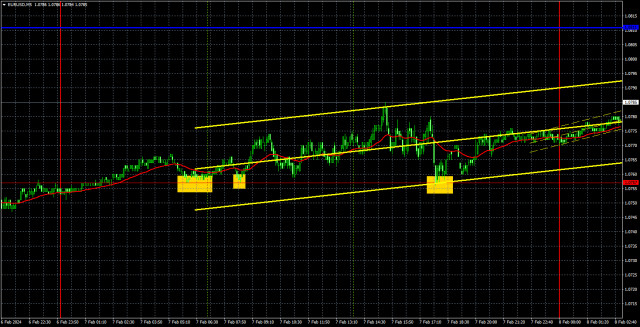Analysis of EUR/USD 5M
EUR/USD continued to correct higher on Wednesday. Volatility was very weak, and yet the pair continues to move upwards. The euro has been moving in a pattern that is quite similar to the sideways movement that we've seen for several weeks, but towards the end of last week, the bears finally took control. The US reports supported the bears, which once again showed that everything is fine with the economy and the labor market, and the Federal Reserve can continue to hold the rate for as long as necessary. Since the market was expecting the first rate cut in March, this information (a hawkish push) supported the dollar.
Also, on Thursday and Monday, Federal Reserve Chief Jerome Powell spoke twice and said that a rate cut in March is unlikely. Some of his colleagues also spoke, confirming that the Fed is not in a rush to trim interest rates, as inflation may still pick up again. We believe that the fundamental background for the US dollar is almost ideal now, and the decline that we saw was quite weak. As for the last two days, there were almost no economic reports, so the market decided to use this to start a corrective move.
Today, the pair may correct higher and even reach the Kijun-sen line. Afterward, we expect the decline to resume, which is unlikely to be strong and fast. Speaking of trading signals, three bounces from the level of 1.0757 were formed yesterday. In each case, the price could not move up by more than 20 pips. The pair also failed to consolidate below the level of 1.0757 during the day. Thus, traders could open long positions based on these signals, but the profit was low due to very weak volatility.
COT report:
The latest COT report is dated January 23. As seen in the charts above, it is clear that the net position of non-commercial traders has been bullish for quite some time. To put it simply, the number of long positions is much higher than the number of short positions. This should support the euro, but we still do not see fundamental factors for the euro to strengthen further. In recent months, both the euro and the net position have been rising. However, over the past few weeks, big players have started to reduce their long positions, and we believe that this process will continue.
We have previously pointed out that the red and green lines have moved apart from each other, which often precedes the end of a trend. At the moment, these lines are still far apart. Therefore, we support the scenario in which the euro should fall and the uptrend must end. During the last reporting week, the number of long positions for the non-commercial group decreased by 9,100, while the number of short positions increased by 6,600. Accordingly, the net position fell by 15,700. The number of buy contracts is still higher than the number of sell contracts among non-commercial traders by 89,000 (it was 104,000). The gap is quite large, and even without COT reports, it is clear that the euro should continue to fall.
Analysis of EUR/USD 1H
On the 1-hour chart, the downtrend persists. Since the US economy continues to show strong results and rarely disappoints, while the European economy remains stagnant, the euro may continue to fall further, which is exactly what we expect. In our opinion, nearly all the current factors indicate that the dollar will strengthen.
On February 8, we highlight the following levels for trading: 1.0581, 1.0658-1.0669, 1.0757, 1,0823, 1.0889, 1.0935, 1.1006, 1.1092, 1.1137, 1.1185, as well as the Senkou Span B (1.0857) and Kijun-sen (1.0811) lines. The Ichimoku indicator lines can move during the day, so this should be taken into account when identifying trading signals. Don't forget to set a breakeven Stop Loss if the price has moved in the intended direction by 15 pips. This will protect you against potential losses if the signal turns out to be false.
On Thursday, there are no important events or reports lined up in the European Union. We can only highlight the US report on unemployment claims, which is released every week. We believe that we will continue to see weak volatility and a corrective nature of movements.
Description of the chart:
Support and resistance levels are thick red lines near which the trend may end. They do not provide trading signals;
The Kijun-sen and Senkou Span B lines are the lines of the Ichimoku indicator, plotted to the 1H timeframe from the 4H one. They provide trading signals;
Extreme levels are thin red lines from which the price bounced earlier. They provide trading signals;
Yellow lines are trend lines, trend channels, and any other technical patterns;
Indicator 1 on the COT charts is the net position size for each category of traders;
Indicator 2 on the COT charts is the net position size for the Non-commercial group.The material has been provided by InstaForex Company - www.instaforex.com
http://dlvr.it/T2SlV2
Are you a forex trader or affiliate marketter that wants to trade forex or make money online.we have the best tips for you here.
Subscribe to:
Post Comments (Atom)
Bitcoin Dips and BlackRock Is Buying: Will BTC Reclaim $72000? - FXLeaders
FX Leaders is an information station for forex , com – modities, indices and cryptocurrency traders. ... Is FX Leaders free to use? Absol...
-
IS CFD TRADING WORTH ITTORIAL: Trading Stock CFDs Worth It? 📝 A topic that is only tangential to Forex, the question of whether to trade st...
-
FX Eagle Dashboard Forex System provides extraordinary trading assistance for its users. THE CURRENCY MATRIX. The indicators are all avai...
-
http://dlvr.it/TF2Sfb

No comments:
Post a Comment